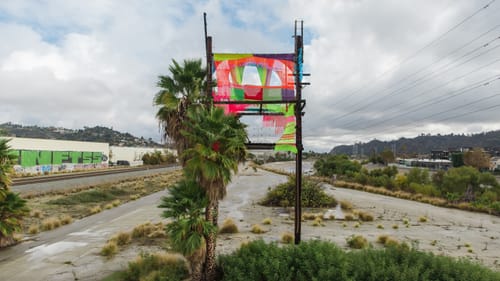Stay in the Loop
BSR publishes on a weekly schedule, with an email newsletter every Wednesday and Thursday morning. There’s no paywall, and subscribing is always free.
Talking queer identity, survival, and collectivity through art with Jesse Harrod

In one untitled 2018 piece by Jesse Harrod, two three-dimensional legs made of goldenrod-hued cord emerge from what looks like a pair of panties, its crotch a snaggle of blue and green loops and loose ends. There is no torso, no face—whose legs are these? Is the figure adult or child, relaxed or ill at ease?—just a backdrop of fuchsia rope knotted into a pattern that recalls the diamonds of a hurricane fence.
Harrod says no matter the medium of their work—fiber, drawings, cloth sculptures, animation, and more recently, tapestry and wood-burning—the questions remain consistent and irresolvable.
It's all about survival
“I’m always thinking about queer survival and queer collectivity and exploring that,” says Harrod, who heads the fiber and materials department at Tyler School of Art. They explore often through materials—rope, foam, sequins—that fall outside the bounds of what is traditionally defined as art. The macrame pieces, Harrod says, were a nod to a 1970s feminist do-it-yourself aesthetic while challenging the whiteness and heterosexism of that period.
“Fiber is embedded with a certain politics and collective memory; how do I engage with that history and make it feel relevant to this moment?” Harrod says. While their early work was more “in-your-face,” such as a 2016 series of posters for a fictitious band called “Vagina ToucHers,” more recent pieces use subtler choices in color, material, and form to skew the viewer’s assumptions. “Part of the queer aesthetic is bumping up against normativity,” Harrod says.

Last month Harrod received a $75,000 grant from the Pew Center for Arts & Heritage—one of 12 unrestricted awards given this year to local musicians, writers, dancers, filmmakers, and visual artists, along with two fellows-in-residence from elsewhere in the United States.
“At this moment of acute challenge precipitated by COVID-19, our grants represent a steadfast belief in the resilience of the Philadelphia region’s cultural community and the abiding importance of the arts in civic life,” Paula Marincola, the Pew Center’s executive director, said in announcing the awards.
DIY community
Harrod’s work includes small parade floats inspired by a Chicago LGBTQ Pride parade, videos that involve exaggerated or animated genitals—one features a “sad and immobile penis [that] dwells alone on a hillside”—and a piece called “The Enormity of Lesbian Grief,” a giant tissue box constructed of found wedding dresses and French beading techniques, meant to evoke the complex, ambivalent feelings that came with the “victory” of marriage equality.
“Queer life is often DIY from the beginning: you’re creating your own sense of community, your own definition of what is family,” Harrod says. “I approach making in that vein of experimentation; it feels connected to my survival and the survival of my community.”
The pandemic has proven to be a prolific time for Harrod. Because they are immunocompromised and all their teaching is now virtual, all their uninterrupted studio hours at Tyler School of Art have prompted even more experimentation, including work on a large tapestry loom.
“For me, making is a form of survival,” Harrod says. “Making is how I enter the world.”
What, When, Where, and Accessibility:
Images and more information about Harrod’s work can be found on their website, jesseharrod.com.
Image description 1: Harrod poses in front of a white brick wall, arms crossed wearing a black leather jacket and scarf, with shoulder-length red hair, straight-faced, looking at the camera.
Image description 2: In a grassy, post-rain area with railroad tracks trailing in the backdrop, a tall wooden and metal structure is lined with brightly colored fabrics.
Sign up for our newsletter
All of the week's new articles, all in one place. Sign up for the free weekly BSR newsletters, and don't miss a conversation.

 Anndee Hochman
Anndee Hochman